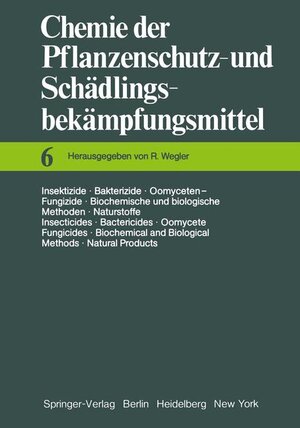
×
![Buchcover ISBN 9783540103073]()
Insektizide · Bakterizide · Oomyceten-Fungizide / Biochemische und biologische Methoden · Naturstoffe / Insecticides · Bactericides · Oomycete Fungicides / Biochemical and Biological Methods · Natural Products
von Richard WeglerInhaltsverzeichnis
- Biology of Pheromones.
- 1. Introduction.
- 2. Biological Function.
- 2.1. Sex Pheromones.
- 2.2. Aggregation Pheromones.
- 2.3. Inhibitors.
- 2.4. Allelochemicals.
- 2.5. Communication Systems.
- 3. Biosynthesis and Release.
- 3.1. Stimulation of Production.
- 3.2. Rhythm of Release.
- 4. Bioassay Methods.
- 4.1. Laboratory Bioassays.
- 4.2. Electrophysiology.
- 4.3. Field Bioassays.
- 5. Genetic Factors.
- 5.1. Alternative Systems.
- 5.2. Population Variations.
- 5.3. Taxonomy.
- 6. Case Histories.
- 6.1. Dendroctonus frontalis.
- 6.2. Trypodendron ( = Xyloterus) lineatum.
- 6.3. Ips typographus.
- 6.4. Lymantria ( = Porthetria).
- 7. Conclusions.
- 8. References.
- Chemistry of Insect Pheromones.
- 1. Insect Behavior Controlling Chemicals in Plant Protection.
- 2. The Chemical Structure of Pheromones.
- Chemical Structure, Occurence, and Behavioral Release of Insect Pheromones and Pheromone Analogs.
- 2.1. Sex Attractants of Female Butterflies and Moths, and Related Compounds.
- 2.2. Pheromones of Male Lepidoptera.
- 2.3. Pheromones of the Bark Beetles (Scolytidae).
- 2.4. Sex and Aggregation Pheromones of Other Beetle Families.
- 2.5. Sex and Aggregation Pheromones of Cockroaches (Blattidae, Orthoptera).
- 2.6. Alarm Substances of Ants (Formicidae, Hymenoptera).
- 2.7. Trail Pheromones of Ants and Termites (Formicidae and Isoptera).
- 2.8. Sex Attractants of Flies (Diptera).
- 2.9. Aphids and Scales (Homoptera).
- 2.10. True Bugs (Heteroptera).
- 2.11. Bees, Wasps, Bumble Bees, Sawflies (Hymenoptera).
- 3. Physiological and Behavioral Activity of Pheromones.
- 3.1. Electrophysiology.
- 3.2. Structure-Activity Relationships.
- 3.3. Multicomponent Pheromone Complexes.
- 3.4. Olfactometer Experiments and Field Tests.
- 4. Isolation and Structure Elucidation of Pheromones.
- 4.1. General.
- 4.2. The Bioassay.
- 4.3. Pheromone Screening.
- 4.4. Pheromone Sources.
- 4.5. Isolation of Pheromones.
- 4.6. Chromatographic Purification and Fractionation for the Identification of Pheromones.
- a) Gel Permeation Chromatography (GPC).
- b) Liquid Chromatography under Normal Pressure.
- c) High Performance Liquid Chromatography (HPLC).
- d) Thin Layer Chromatography (TLC).
- e) Gas Chromatography.
- 4.7. Identification and Structure Elucidation.
- a) Ultrared Spectroscopy.
- b) Ultraviolet Spectroscopy.
- c) Nuclear Magnetic Resonance — NMR — Spectroscopy.
- d) Mass Spectroscopy.
- e) Gas Chromatographic Techniques.
- 5. Synthesis of Insect Pheromones.
- 5.1. Butterflies and Moths — Lepidoptera.
- a) Wittig Olefination and Related Methods.
- b) The “Acetylenic Approach” to Pheromone Synthesis.
- c) Reduction of Allyl Diethyl Phosphonates.
- d) Coupling Reactions with Organometallic Reagents.
- e) [3.3]-Sigmatropic Reactions.
- f) Transition Metal Catalyzed Metathesis Reaction.
- g) Electrochemical Procedures.
- h) Stereoselective Syntheses of Chiral Lepidoptera Pheromones.
- 5.2. Beetles — Coleoptera.
- a) Scolytidae — Bark Beetles.
- b) Dermestidae.
- c) Curculionidae.
- d) Bruchidae.
- 5.3. Flies — Diptera.
- 5.4. Hymenoptera.
- 5.5. Pheromones of Isoptera.
- 5.6. Synthesis of Cockroach Pheromones (Blattaria).
- 6. Acknowledgement.
- 7. References.
- Die praktische Verwendung von Insektenpheromonen.
- 1. Einleitung.
- 2. Sexuallockstoffe und Aggregationspheromone.
- 2.1 Pheromone als Indikatoren.
- 2.2. Bekämpfung von Schädlingen im Anlockverfahren.
- 2.3. Störung der chemischen Kommunikation.
- 2.4. Lockstoffe als Hilfsmittel für andere Verfahren.
- 3. Anwendungsmöglichkeiten sonstiger Pheromone.
- 4. Umweltprobleme und Nebenwirkungen.
- 5. Entwicklung und Stand der Pheromon-Anwendung.
- 5.1. Forst und Gehölze.
- 5.2. Obst, Wein, Oliven.
- 5.3. Getreide.
- 5.4. Baumwolle.
- 5.5. Sonstiger Acker- und Gartenbau.
- 5.6. Vorratsschutz.
- 5.7. Hygiene, Medizin and Veterinärmedizin.
- 6. Tendenzen, Probleme, Aussichten und Grenzen.
- 7. Literatur.
- The Use of Juvenoids in Insect Pest Management.
- 2. The Role of Endogenous Juvenile Hormones.
- 3. Effects of Exogenous Application of Juvenoids.
- 3.1. Morphogenetic Effects.
- 3.2. Ovicidal Effects and Disruption of Embryogenesis.
- 3.3. Effects on the Reproductive System and Fecundity.
- 3.4. Effects on Diapause, Polymorphism, and Behaviour.
- 4. The Use of Juvenoids Against Pest Species.
- 4.1. Pests of Field Crops, Silviculture, and Horticulture.
- 4.2. Pests of Medical and Veterinary Importance.
- 4.3. Pests of Stored Products.
- 4.4. Household, Domestic, and Other Pests.
- 4.5. The Use of Juvenoids in Sericulture.
- 5. Some Factors Influencing the Practical Use of Juvenoids.
- 5.1. Choice of Target Species.
- 5.2. Metabolism, Resistance, and Synergism.
- 6. Conclusions.
- Pflanzenschutzpräparate mikrobieller Herkunft.
- 1. Einführung.
- 2. Fungizide und Bakterizide.
- 2.1. Einleitung.
- 2.2. Handelsprodukte.
- 2.3. Forschungs- und Entwicklungspräparate.
- 3. Insektizide.
- 3.1. Einleitung.
- 3.2. Handelsprodukte.
- 3.3. Forschungs- und Entwicklungspräparate.
- 4. Herbizide und Wachstumsregulatoren.
- 4.1. Einleitung.
- 4.2. Forschungs- und Entwicklungspräparate.
- Insektizide Phosphorsäureester.
- 2. Insektizide vom Typ der (Thio)Phosphorsäure-arylester.
- 3. Insektizide vom Typ der (Thio)Phosphorsäure-heteroarylester.
- 4. Insektizide vom Typ der (Thio)Phosphorsäure-thioalkylester.
- 5. Insektizide vom Typ der Enol(thio)phosphorsäureester.
- 6. Sonstige.
- Bacterial Plant Diseases and Their Control.
- 2. The Economic Importance of Bacterioses.
- 3. The Causative Agents of Bacterioses.
- 3.1. Classification and Taxonomy.
- 3.2. Bacterial Genera to which Causative Agents of Bacterioses are Assigned.
- 4. Examples of Bacterial Plant Diseases.
- 4.1. Bacterial Leaf Blight of Rice.
- 4.2. Fire Blight of Pear and Apple.
- 4.3. Lethal Yellowing of Coconut Palms.
- 5. Control of Bacterial Plant Diseases.
- 5.1. Biological Aspects.
- 5.2. Chemical Control — General Considerations.
- 6. Chemistry of Bactericidal Compounds.
- 6.1. Inorganic, Nonmetallic Compounds.
- 6.2. Inorganic and Organic Metal Compounds.
- 6.2.1. Mercury Compounds.
- 6.2.2. Copper Compounds.
- 6.3. Dithiocarbonates and Dithiocarbamates.
- 6.4. Alcohols and Other Aliphatic Compounds.
- 6.5. Aromatic Compounds.
- 6.6. Heterocyclic Compounds.
- 6.6.1. Heterocyclics Containing Nitrogen.
- 6.6.2. Heterocyclics Containing Nitrogen and Sulfur.
- 6.7. Antibiotics.
- Recent Advances in the Chemical Control of Oomycetes.
- 2. Biology of Plant-Pathogenic Oomycetes.
- 2.1. Foliar Plant Diseases Caused by Oomycetes.
- 2.2. Soilborne Seedling and Root Diseases Caused by Oomycetes.
- 3. Traditional Control of Oomycetes by Nonsystemic Fungicides.
- 4. Chemistry and Biological Properties of Systemic and Specific Fungicides Against Oomycetes.
- 4.1. Earlier Fungicides with Specific Activity Against Oomycetes.
- 4.1.1. Fenaminosulf.
- 4.1.2. Etridiazole.
- 4.1.3. Chloroneb.
- 4.1.4. Hymexazol and Related Compounds.
- 4.2. Pyroxychlor and Other Pyridines.
- 4.3. Prothiocarb and Propamocarb.
- 4.4. Curzate.
- 4.5. Ethyl Phosphites.
- 4.6. Acylalanines and Related Compounds.
- 4.7. Miscellaneous New Fungicides Against Oomycetes.
- 5. Discussion of Disease Control Strategies with the New Systemic Fungicides Against Oomycetes.
- 5.1. Novel Disease Control Possibilities with Systemic Fungicides.
- 5.2. Utilization of Curative and Systemic Properties for Integrated Disease Control Strategies.
- 5.3. The Risk of Fungicide Resistance.
- 6. References.
- Benzoylphenylurea Insecticides.
- 2. Synthesis of 1-benzoyl-3-phenylureas.
- 3. Diflubenzuron, Physical/Chemical Properties and Analysis.
- 3.1. Physical and Chemical Properties.
- 3.2. Analysis.
- 4. Formulations.
- 5. Toxicology.
- 5.1. Mammalian Toxicity.
- 5.1.1. Acute Toxicity.
- 5.1.2. Sub-acute Toxicity.
- 5.1.3. Semi-chronic Toxicity.
- 5.1.4. Chronic Toxicity.
- 5.1.5. Special Studies.
- 5.2. Toxicity to Birds.
- 5.3 Toxicity to Fish.
- 6. Mode of Action.
- 6.1. Biological Aspects.
- 6.1.1. Larvicidal Effects.
- 6.1.2. Ovicidal Effects.
- 6.1.3. Effects on Adult Insects.
- 6.2. Biochemical Aspects.
- 7. Distribution and Metabolism.
- 7.1. Distribution and Degradation of Diflubenzuron in Soil and Water.
- 7.2. Plants and Other Organic Matrices.
- 7.3. Animal Metabolism.
- 7.4. Metabolism in Insects.
- 7.5. Behaviour in Ecosystems.
- 7.6. Residues.
- 7.6.1. Plant Residues.
- 7.6.2. Residues in Animal Tissues.
- 7.6.3. Residues in Mushrooms.
- 8. Fields of Application.
- 8.1. Introduction; Selectivity.
- 8.2. Agricultural Crops.
- 8.2.1. Cotton.
- 8.2.2. Soybeans.
- 8.2.3. Corn.
- 8.3. Horticultural Crops.
- 8.3.1. Fruit Crops.
- 8.3.2. Mushrooms.
- 8.3.3. Floriculture.
- 8.3.4. Cabbage.
- 8.4. Forestry and Woody Ornamentals.
- 8.5. Medical-hygienic and Veterinary Applications, Including Control of Nuisance Insects.
- 8.5.1. Mosquitoes and Midges.
- 8.5.2. Flies.
- 8.5.3. Blackflies.
- 8.5.4. Tsetse Flies.
- 8.5.5. Chewing Lice.
- 8.6. Effects on Non-targets, not Related to a Specific Field of Application.
- 8.6.1. Honey Bees.
- 8.6.2. Non-target Aquatic Organisms.
- 8.7. Nematicidal Effects.
- 9. Resistance.
- 9.1. Cross Resistance.
- 9.2. Build-up of Resistance Against Diflubenzuron.
- 10. Structure-Activity Relationship.
- 11. Experimental Products.
- 11.1. Experimental Compounds of Bayer AG.
- 11.2. Experimental Compounds of Eli Lilly.
- 11.3. Experimental Compound of Philips-Duphar.
- 12. Literature and Patents.
- Zur Problematik des biologischen Pflanzenschutzes in der Landwirtschaft.
- 1. Problemstellung und Abgrenzung.
- 2. Problemumfang.
- 3. Praktische Aussichten der biologischen Unkrautbekämpfung.
- 4. Praktische Aussichten der biologischen Bekämpfung von Schadpilzen.
- 5. Biologische Bekämpfung von Insekten und anderen tierischen Schädlingen.
- 5.1. Verschleppte Schädlinge.
- 5.2. Autochthone Schädlinge.
- 5.3. Methoden der biologischen Schädlingsbekämpfung.
- 5.3.1. Die Verwendung von Parasiten.
- 5.3.2. Die Verwendung von Prädatoren.
- 5.3.3. Die Verwendung von Mikroorganismen.
- 5.3.4. Autozidverfahren.
- 6. Nebenwirkungen und Gesichtspunkte der amtlichen Zulassung.
- 7. Diskussion.
- 8. Schlußbetrachtung.
- 9. Literatur.




